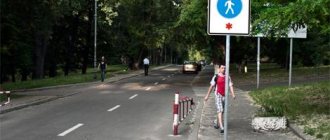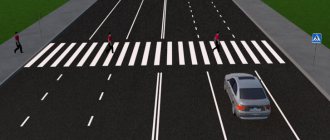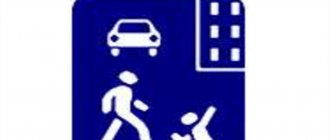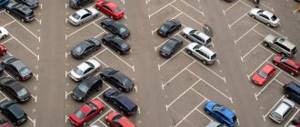Cars are rightful masters on the roads. A pedestrian feels uncomfortable crossing traffic. In the residential area the situation is reversed. Here, the convenience and safety of citizens is more important than the convenience of the motorist.
Dear readers! Our articles talk about typical ways to resolve legal issues, but each case is unique. If you want to find out how to solve your particular problem, please use the online consultant form on the right or call. It's fast and free!
The rules of the State Traffic Inspectorate enshrine the concept of a residential zone. Strict measures are applied to rule violators: deprivation of rights, fines. However, many drivers poorly understand the purpose of the network of local roads within such a zone and use them for through travel.
Residential zone sign and its installation locations
Entry into the territory of a residential zone is determined by a special mandatory sign 5.21.
A diagonally crossed sign (5.22) marks the end of the residential area. The driver who finds himself in the zone of their action is obliged to follow the established traffic order.
Their installation location is:
- residential area in a residential area;
- private sector within the city;
- cottage village;
Such signs are not installed in courtyard areas unless absolutely necessary. This circumstance should not be misleading, since the traffic rules there are the same.
These special signs are installed by local municipalities. At the request of citizens, if these measures are not enough to maintain order, the passage of any transport is prohibited, except for:
- special transport for emergency services;
- personal cars of residents;
- mail, taxi, delivery;
A car blocked the entrance to the yard: what to do
If a car has blocked the entrance to the yard for another car, you should do something to eliminate the problem within the limits of the law:
- First, talk to its owner to remove the vehicle. Sometimes this situation is forced, short-term, and the driver disturbing others leaves a note with his phone number on the windshield of the car. You can rock or gently kick the car to set off the alarm. Then there is a chance that the owner will quickly show up himself.
More on AutoLex.Net:
Basic rules, in which cases a tram must give way, analysis of situations described in traffic rules
- If there is no response or it is impossible to find the driver, call the traffic police. You need to explain the situation, give the address and name the registration number of the car blocking the road. The inspector will contact its owner, and it will be easy for the police to find his phone number. If unsuccessful, the traffic police will call a tow truck. The car that has become an obstacle will be removed to a special parking lot. Moreover, its owner will pay for the movement and location of the vehicle there.
If a motorist is blocked from entering the courtyard of the building where he has an apartment, this is illegal, and you need to deal with the homeowners association. It does not have the right to deprive the property owner of the opportunity to enter the territory that is common to all residents of the house. This norm is established by clause 5 of Article 16 of the Law “On the Entry into Force of the Housing Code of the Russian Federation”:
From the moment the land plot is formed and its state cadastral registration is carried out, the land plot on which the apartment building and other real estate objects included in such a building are located passes free of charge into the common shared ownership of the owners of the premises in the apartment building.
And also Article 262 of the Civil Code of the Russian Federation, which states that people have the right to be on land plots that are not closed to public access and to use the objects located on them.
The Supreme Court of the Russian Federation considered a similar case, and the decision was made in favor of the one who was denied entry into the yard by the general meeting. If we are talking about the car of a person who does not live in an apartment building, if there is a legally installed barrier, they have the right to prohibit him from being in this adjacent territory.
There may be a “Do Not Occupy Entry” sign near the entrance to the area, and this requirement must be obeyed. The same designation is attached to gates that close the courtyards of private houses, and there it has the right to exist.
Watch this video about what to do if a car blocks the passage to the yard:
Residential zone in traffic rules
A residential zone is an area whose boundaries are indicated by road signs 5.21 and 5.22. Section 17 of the Highway Code requires a number of rules to be followed within this zone. In courtyard areas, these rules are also mandatory.
A courtyard area is a space inside the perimeter formed by residential buildings, or between buildings, on which flower beds, lawns, recreation areas, children's and sports grounds are located.
- The roadway located inside such a zone is primarily intended for pedestrians and cyclists; they have priority here.
- The car must allow them to pass (check-in and check-out is no exception). Unnecessarily, pedestrians (cyclists) do not need to interfere with the movement of cars.
- The speed is limited to 20 km/h.
- Prohibited:
- educational driving;
- through traffic;
- parking for category “C” freight vehicles;
- parking with the engine running;
Correct parking
The Administrative Code and traffic rules in courtyards and residential areas prohibit:
- park trucks weighing more than 3.5 tons (if there is no special parking);
- park:
- in flower beds, lawns or areas with plantings;
- on children's or sports grounds;
- on sidewalks;
Drivers leave their cars under apartment windows to keep an eye on them. There are not enough parking spaces in the courtyards, but this does not change the basic rules:
- the car should not block access roads;
- there is no need to interfere with pedestrians;
- Reverse must be done very carefully; children and pets are not visible in the blind spot;
If these rules are neglected, the following consequences are possible:
- a fire truck or ambulance will not be able to get through in time to help the victims;
- the conflict situation will end in traumatology;
- a criminal case will be initiated regarding the collision with the child;
- you will have to pay a fine;
Is leaving the yard considered an intersection?
Leaving the yard, according to traffic regulations, is not considered an intersection. Here is what is said about this in the “General Provisions” of the legal document:
Crossroads" is a place where roads intersect, join or branch at the same level, limited by imaginary lines connecting, respectively, the opposite, most distant from the center of the intersection, beginnings of curvatures of roadways. Exits from adjacent areas are not considered intersections.
Therefore, the rules for driving through intersections at the exit from the yard do not work.
More on AutoLex.Net:
What are the markings on the road according to traffic regulations?
Sometimes it is difficult for the driver to understand what exactly is in front of him - an intersection of roads or a section leading from the adjacent territory. To figure it out, you should look at nearby objects. For example, a traffic light is installed only at an intersection, but not at the exit from a residential area. Signs 2.3.1-2.3.7 and plate 8.13 too.
How long does a driver need to comply with restrictions?
Residential or courtyard areas are not intended for the transit of vehicles. You should only enter it if necessary:
- you live in this place;
- came to someone on business;
- you work there;
- intend to buy something;
- it is necessary to disembark a passenger or unload cargo (pick up a passenger, load cargo);
From the moment you entered the coverage area of sign 5.21 or any courtyard area until the moment you left (sign 5.22), you are required to follow the traffic rules established by the traffic police.
How to limit the movement of vehicles in the yard of a house
Interesting: most often, to limit the speed when driving through courtyards, sign 5.21 “Residential zone” is installed.
If you carefully study the rules that govern the driver entering under the “Residential Zone” sign, the restrictions also apply to training driving. It is worth conducting classes in other places that are roads without such status, and also not related to main transport routes. The sign also applies to special vehicles belonging to driving schools.
Based on this article, inspectors never allow the installation of barriers in the courtyards of residential buildings, no matter what scandals are created by those who want to restrict access to their yard.
Thus, you need to focus on signs 5.21 and 5.22. If they are not there, then a speed limit sign is usually posted: 3.29 to 20 or 5 kilometers per hour.
Residents of the house at 11 Nedelina Street are tired of fighting with drivers who constantly drive through their yard and daily threaten the lives of children playing in the street. Complaints do not help, and the authorities only turn a blind eye to the problem.
It is possible to block the entry of strangers into your yard legally: a security guard will be on duty around the clock at the barrier to ensure free access. But in a residential yard this is hardly possible. And the salary of a security guard is beyond the means of most residents of the house. Putting a barrier in your yard so that no stranger’s car can drive into the yard, and not putting your car there, is a completely normal desire to protect your territory. But is the installation of barriers legal?
Therefore, when leaving a “residential area”, the driver is obliged to let both pedestrians and other vehicles pass, regardless of the direction of their movement.
Control over driver actions
Very often, a driver, being in a residential area or in a courtyard, thinks that the State Traffic Inspectorate and traffic rules are absent here. If the traffic police inspector is not nearby, then this is not a reason for violating the order established by the rules.
Ways to identify violators:
- various complexes for automatically recording violations:
- stationary - the most advanced (“arrow”, “gyrfalcon”, “auto patrol”, etc.);
- mobile systems - quickly installed in the right place;
- mobile - work in motion mode (for example, parking lots)
- any conscientious citizen has every right to write a complaint to the traffic police and attach to it video recordings and photographs taken with any available device;
- highway patrol;
Traffic rules for residential areas and courtyards
In connection with all this, residents have a desire to install a “Residential Zone” sign, which prohibits through passage through its territory.
However, the latter should not create intentional obstacles - for example, smoking while standing on the road, or deliberately blocking the path of transport. This will be regarded as a gross offense - especially if it creates an obstacle for the passage of a special services vehicle.
For reference: installation of an automatic barrier up to 4 meters long on a turnkey basis costs 40-50 thousand rubles.
The speed of movement both in residential areas and in courtyard areas should not exceed more than 20 km/h (clause 10.2 of the Russian Traffic Regulations).
Fines for violations in residential areas
An unscrupulous motorist will pay the largest fines in a major city. The fine can range from 1,000 rubles to 5,000 rubles. Legal entities and officials are fined more serious amounts.
Damage to plants in a landscaped area in Moscow costs:
- 4000 rubles for a simple car enthusiast;
- 50,000 rubles to an official;
- 300,000 rubles to a legal entity;
The reason for the fine will be:
- parking in the wrong place (sidewalk, lawn, recreation area, etc.);
- parking with the engine running (more than 5 minutes);
- parking a truck weighing more than 3.5 tons (more than 5 minutes);
- speeding;
In the event of serious violations resulting in an accident or collision with a person:
- fines reach up to 200,000 rubles (for individuals);
- criminal liability (imprisonment from 3 to 7 years);
- deprivation of a driver's license (from 1 to 3 years);
A car driver should always remember that owning a car comes with a burden of responsibility. The cost of the car does not give the driver any advantages over traffic rules, the Code of Administrative Offenses of the Russian Federation, and the Criminal Code of the Russian Federation. Residential areas and courtyard areas require increased attention and caution from the driver.
Didn't find the answer to your question? Find out how to solve exactly your problem - call right now: +7 (Moscow) +7 (812) 309-53-42 (St. Petersburg) It's fast and free!
Free online consultation with a car lawyer
Didn't find the answer to your question? Find out how to solve exactly your problem - call right now: +7 (Moscow) +7 (812) 309-53-42 (St. Petersburg) It's fast and free!
Rules for moving and stopping when there is a sign 5.21
This sign requires compliance with a number of rules:
- Speed limit up to 20 km/h;
- Giving priority to pedestrians. The driver must let them through. Pedestrians, in turn, undertake not to intentionally block the roadway or create interference on it;
- Yard areas are not intended for through passage; it is prohibited to use them to reduce the length of the route. Many drivers decide to do this. They often do not obey the speed limit;
- The yard area is not designed for maneuvering.
If the driver still needs to drive through courtyards, then such an action will not be recognized as a through passage if the motorist stops for less than five minutes.
In residential areas, among other things, it is prohibited:
- Training ride;
- Parking with the engine running;
- Parking for category “C” vehicles.
If the residents of the house need to transport things, then the truck should not be located in the yard area for more than five minutes. This requirement does not apply to trucks with a plate, as well as to utility vehicles.
Departure from a residential area should be carried out in the same way as departure from other territories.
The driver must comply with some requirements:
- Give priority to other cars driving on the main road, pedestrians, etc.;
- When leaving, it is prohibited to cross a solid line, if there is one. You can only turn to the right.
Parking on playgrounds and lawns is a common violation. You can leave your vehicle only in the places provided for this.









